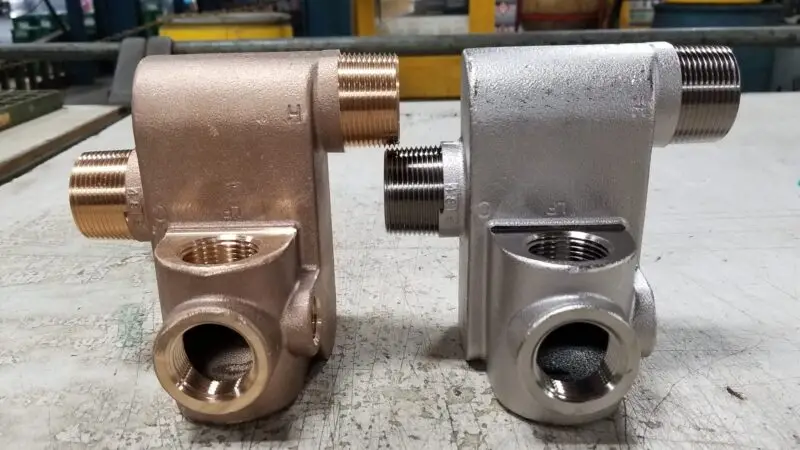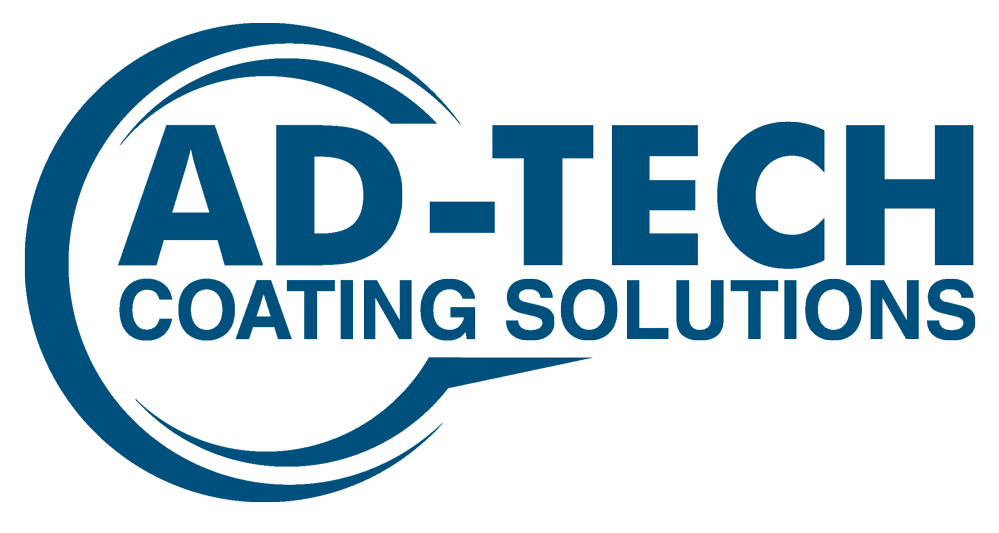Ad-Tech Coating Solutions - Industrial Coating & Finishing Services
Electroless Nickel Plating
Using our nearly 50 years of experience in the coatings industry, we designed and built a superior Electroless Nickel Plating finishing line. Our state-of-the-art nickel plating line uses only ROHS and ELV compliant mid and high-phos chemistry, allowing us to produce high quality coatings with quick turn around at a fair price. Our quality team guarantee’s it!
What Is Electroless Nickel Plating?
Electroless nickel (EN) plating is an auto-catalytic reaction that deposits a nickel coating on a substrate, such as metal or plastic. It provides wear-resistance, hardness, and corrosion protection of the substrate.
Electroless nickel-phosphorus is used when wear-resistance, hardness, and corrosion protection are required. Ferrous and non-ferrous surfaces of any geometry can be plated using Electroless Nickel Plating, making it a versatile option for many substrates.
Our facility can perform EN Plating on a variety of substrates, including:
- Steel
- Stainless Steel
- Brass
- Copper
Our EN Plating line uses a rack and barrel and has enough room to accommodate parts 28 inches wide, 44 inches long, 32 inches deep, and up to 500 pounds.
Applications
Electroless plating has many industrial applications, from merely decorative to preventing corrosion and wear. EN Plating is also free from flux density and power supply issues.
Some of the most common industries that use this application include…
- Automotive: Higher quality and superior performance components with EN Plating satisfy the public’s demand for longer warranty vehicles.
- Chemical Equipment: EN Plating provides excellent resistance to chemical damage in harsh environments.
- Salvage and Repair: EN Plating builds up worn or mis-machined parts at a more affordable price.
Chemical equipment that works with EN Plating can include optical surfaces for diamond turning, doorknobs, kitchen utensils, bathroom fixtures, electrical/mechanical tools, and office equipment.
Due to the high hardness of the EN coating, it can be used to salvage worn parts. Coatings of 25 to 100 micrometers can even be applied and machined back to the final dimensions. It can also be applied with little or no compressive stress, thus making it gentle in application.
EN Plating Benefits
EN Plating has several benefits due to its versatility, including aesthetic benefits. After a substrate is plated, the finished part’s surface is smooth, nearly pore-free, uniform, and free from defects, providing a great corrosion-resistant and attractive coating. It can also easily fill recesses or pits in the metal’s surface, resulting in a uniform surface finish.
Since Electroless Nickel Coating is a surface treatment that provides wear, abrasion, erosion, and corrosion resistance, it also has a low-friction coefficient, producing less heat and potential damage to other parts. This coating ensures the part can function for a long time, increasing its service life.
This process also has a uniform thickness, including corners and edges, compared to an electrolytic process. This coating is intended for applications where resistance to acids and well-wear is needed.

ASTM B-733 - Standard Specification for Autocatalytic (Electroless) Nickel-Phosphorus Coatings on Metal
Key Benefits Of ASTM B733
ASTM B733 provides numerous advantages to industries that employ electroless nickel plating. Here are some of the key benefits:
- Enhanced Corrosion Resistance – crucial for parts exposed to harsh environmental conditions
- Increased Wear Resistance – nickel-plated surfaces have increased wear resistance beneficial for parts subjected to friction and mechanical stress
- Uniform Coating Application – is important for complex shapes and sizes that need every surface of a part protected
- Cost-Effectiveness – extending the life and reliability of a component helps reduce maintenance and cost
- Regulatory Compliance – comply with regulatory requirements helps companies avoiding potential legal issues and fines
Application of ASTM B733
The successful application of EN coatings, according to ASTM B733, involves several steps to ensure adherence to standards performance. Here are some key factors we focus on:
- Surface Preparation
- Coating Process
- Post-Application Treatment
- Quality Control And Testing
Complying With ASTM B733
It is important to compliance with ASTM B733 in our electroless nickel plating process to ensure product quality, safety, and performance. Here are steps we take to ensure compliance:
- Obtaining and thoroughly understanding the ASTM B733 standard
- Develop and implement strict quality control procedures
- Ensure Proper Training And Equipment
- Maintain records of processes, inspections, and compliance checks
- Conduct regular audits of the coating process
Coating Classification
TYPE describes the general composition of the deposit with respect to the phosphorus content. Type is divided into
five categories:
Type I: No requirement of phosphorous
Type II: 1-3% phosphorous
Type III: 2-4% phosphorous
Type IV: 5-9% phosphorous
Type V: 10% or greater phosphorous
Service Condition numbers are based on the severity of the exposure in which the coating is intended to perform and minimum coating thickness to provide satisfactory performance
SC0: Minimum Thickness 0.000004
SC1: Light Service 0.0002
SC2: Mild Service 0.0005
SC3: Moderate Service 0.001
SC4: Severe Service 0.003
Post Heat Treatment Class—The nickel-phosphorus coatings shall be classified by heat treatment after plating to increase coating adhesion or hardness, or both.
Class 1: As-deposited, no heat treatment
Class 2: Heat treatment at 260 to 400°C (500-752°F) to produce a minimum hardness of 850 HK100
Class 3: Heat treatment at 180 to 200°C (356-392°F) for 2 to 4-hr to improve coating adhesion on steel and to provide for hydrogen embrittlement relief
Class 4: Heat treatment at 120 to 130°C (248-266°F) for at least 1-hr to increase adhesion of heat-treatable (age-hardened) aluminum alloys (such as 7075) and carburized steel
Class 5: Heat treatment at 140 to 150°C (284-302°F) for at least 1-hr to improve coating adhesion for aluminum, non age-hardened aluminum alloys, copper, copper alloys and beryllium
Class 6: Heat treatment at 300 to 320°C (572-608°F) for at least 1-hr to improve coating adhesion for titanium alloys
ASTM B-733 Keywords: autocatalytic; chemical nickel; coatings; conductive; corrosion resistance; electroless; functional; nickel; nickel phosphorus; wear resistance

Applications Of Electroless Nickel Plating
This method is widely used due to its ability to coat parts uniformly, regardless of their shape. A few applications of electroless nickel plating:
- Aerospace And Defense Industries – EN is perfect for high tolerance demands for aircraft, satellites and UAV components
- Automotive: auto parts that are exposed to high temperatures and frictional, fuel systems, engines, and braking systems
- Chemical Equipment: EN provides an excellent resistance to chemical damage in harsh environments
- General Industries: various industries, including oil and gas, maritime, and electronics
Facility Capabilities
Substrates:
- Steel
- Stainless Steel
- Brass
- Copper
Methods:
- Rack and Barrel
Size and Weigh Limits:
- 28″W x 44″L x 32″D
- 500 pounds

Choose Ad-Tech Coating Solutions for Your Electroless Nickel Plating Needs
Ad-Tech Coating Solutions is proud to have the fastest turnaround time in the industry. Thanks to our high-quality standards and professional and knowledgeable team, we’ll create the EN Plating you need for your product.
Ad-Tech Coating Solutions can provide customers around Watertown, WI, with a quote. Just contact us to get started today.
EN Plating, Electroless Nickel Advantages
Appearance – The finished parts surface is smooth, nearly pore free, uniform and free from any defects, providing a great corrosion resistance attractive coating.
Cleaning Process – Parts must be free of rust, scale, oil, grease and dirt prior to treatment. All parts go through a multi stage washer to ensure surfaces are properly prepared for plating.
Application – Electroless Nickel Coating serves as a surface treatment that provides wear, abrasion and erosion resistance and/or corrosion resistance. It also has a low coefficient of friction. This process has a very uniformed thickness including corners and edges compared to an electrolytic process. This coating is intended for applications where resistance to acids and well wear is needed.

